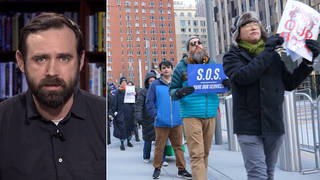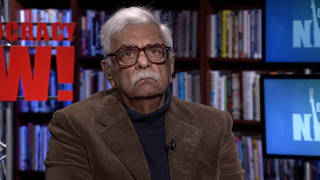
Related
Guests
- Barbara Hinesformer director of the Immigration Clinic at the University of Texas Law School. Her affidavit in a lawsuit challenging detention of women and children as a method of deterrence to mass migration was cited by the federal judge in his order to halt the practice.
- Renée FeltzDemocracy Now! producer and criminal justice correspondent.
The Obama administration continues to expand its controversial practice of detaining mothers and their children despite a judge’s order that using it to deter mass migration is illegal. Starting last summer, thousands of Central American women with kids as young as a few months old crossed into the United States seeking asylum. Even though many were later found to have a “credible fear” of violent persecution, they found themselves rounded up and put into detention, with little chance for freedom until they were deported. But last month, a federal judge ordered immigration authorities to begin releasing the women and children. He found the Obama administration’s policy of detaining them in order to deter others from coming was illegal. Since then, more families have been granted bond and released, while others who are unable to afford the bonds remain locked up. They are held at one of two new family detention centers run by private prison companies in southern Texas. We air an on-the-ground report from Texas by Democracy Now! producer Renée Feltz, who speaks to a recently released mother and her son. We are also joined by Barbara Hines, former director of the Immigration Clinic at the University of Texas Law School. Hines’ affidavit in a lawsuit challenging detention of women and children as a method of deterrence to mass migration was cited by the federal judge in his order to halt the practice.
Click here to watch Part 2 of this discussion.
Transcript
JUAN GONZÁLEZ: We end today’s show with an update on a story Democracy Now! has followed closely: President Obama’s expansion of the controversial practice of detaining mothers and their children. Starting last summer, thousands of Central American women with kids as young as a few months old crossed into the United States seeking asylum. Even though many were later found to have a credible fear of violent persecution, they found themselves rounded up and put into detention, with little chance for freedom until they were deported.
AMY GOODMAN: But last month a federal judge ordered immigration authorities to begin releasing the women and children. He found the Obama administration’s policy of detaining them in order to deter others from coming was illegal. Since then, more families have been granted bond and released, while others who are unable to afford the bonds remain locked up. They’re held at one of two new family detention centers run by private prison companies in South Texas. Democracy Now!’s Renée Feltz went there to find out more. She filed this report.
RENÉE FELTZ: My first stop in Texas is a small town called Dilley. An hour north of the Mexican border, just off Interstate 35, is a family detention center that opened in December. It was built on the site of a former man camp for oil field workers. I meet a resident who lives nearby and offers to show me around.
DILLEY RESIDENT: Here we are at the South Texas Family Residential Center. Pretty far out of sight. And out of sight, out of mind.
RENÉE FELTZ: We drive around a 50-acre site now run by Corrections Corporation of America. It’s filled with hundreds of mud-colored trailers. Each one can house eight people, or about three families. Much of the site is surrounded by a high fence. But peeking through it, I can see rows of trailers stretching into the distance. In one area, the top of a playground rises above the fence, and I can hear children’s voices. Much of the site is still under construction. Two large tents look like they’ve just been finished, each one big enough for hundreds of beds. When the facility is done, it will be able to hold 2,400 women and children. I asked my contact what Dilley residents think of it all.
DILLEY RESIDENT: What I’ve heard the most is, “Hey, they’re building a new detention facility over there. I’m going to ask them for a job.” Or showing someone the headline in the local paper that came out the week that they announced this, and it said, “Feds OK internment camp at Dilley.” And the sub-headline was: “Opportunities for job employment.”
RENÉE FELTZ: In fact, this part of Texas is no stranger to the detention of families. In 1942, the nearby town of Crystal City was home to an internment camp for Japanese and German men, along with their wives and children.
PRESIDENT FRANKLIN D. ROOSEVELT: The filming of the Crystal City facility, which you are about to see, shows how men, women and children, detainees of World War II, lived, worked and played under traditional American standards of decent and humane treatment.
RENÉE FELTZ: Details from a 1946 government film about the Crystal City internment camp sound eerily similar to the present-day camp in Dilley about an hour away.
FILM NARRATOR: Originally, it was a migratory labor camp of approximately 100 housing units, utility and recreation buildings. To provide for a population of 3,600, we added more than 500 housing units. Plastic camp money was issued to them in accordance with the size and needs of the family. Here are some children at play under the direction of a detainee teacher.
RENÉE FELTZ: Most of the women and children interned in Crystal City were U.S. citizens. The government later apologized for their treatment. Today, the women and children detained in Dilley are immigrants from El Salvador, Honduras and Guatemala. But their detention has drawn similar scrutiny. In February, a federal judge ordered immigration authorities to begin releasing the women and children. Since then, many judges have granted them bonds between $4,000 and $10,000. If the women and children can pay, they are released to live with relatives while they seek legal status. But some detainees can’t afford their bonds, and others are ineligible if they’ve been deported before. Still, while I’m at Dilley, I do see a group of newly freed detainees being loaded into a small white bus. One of my sources tells me they’ll be dropped off at the Greyhound bus station about an hour north in San Antonio. I decide to meet him there and find out.
And we’re here speaking with?
MOHAMMAD ABDOLLAHI: Mohammad Abdollahi. I’m with RAICES, the Refugee and Immigrant Center for Education and Legal Services. We work in collaboration with the Interfaith Welcome Coalition. And each night we’re here at the Greyhound bus station in downtown San Antonio, where we have vanfuls of women that are usually brought from either of the family detention centers. And usually what unfolds is the women come in the facilities, and it’s very surprising for us, in that the women are usually released from detention in the same clothing that they were probably caught in in the summer.
RENÉE FELTZ: As I talked to Mohammad, a van stops by and drops off a group of five mothers and eight children. They had been held at the other family detention center in Karnes City. Most will travel for days to live with an approved family member or friend. But they have no money or supplies, so the Interfaith Welcoming Committee brings them backpacks full of donated food, toys and diapers. Volunteer Rebecca Ortiz lists the ages of the newly freed people she’s met.
REBECCA ORTIZ: As young as 10 months, two weeks, usually three and four, seven, 10. Just recently we’ve seen some teenagers. They’re dropped off here at the bus station. And we’re here to help them, because we know that they don’t understand English. We’re here to help translate their tickets, show them how to read the tickets, explain the journey. Sometimes we’ll have a map of the United States, because they have no idea that they’re in Texas, or they know they’re in Texas, but they don’t know how far it’s going to be when they travel to California or Florida or Massachusetts or New York, Montana, Wyoming. So we have the map, and we show them, “You’re here, and you’re going to travel through here, you know, until you reach your destination.” And we may not have control over things our government does. We have no control over what a foreign government does. But when someone is standing in front of you, who needs help, we’re ready.
RENÉE FELTZ: As families wait to board their buses, I watch a volunteer give the kids stuffed animals she pulls from her purse. She’s been helping the women when they were detainees to connect with lawyers. She tells me about the ID cards issued to them inside.
JOHANA DE LEON: This is the ID for one of our clients that we had, Patricia—oh, I don’t want to say her name, but just Patricia. We represented her in a pro bono capacity. We helped her with her bond representation. She was there for three months, and after three months she got a $5,000 bond, that also, with the help of the Interfaith Welcome Coalition, we were able to raise money and pay that bond on behalf of her.
RENÉE FELTZ: So, you’re holding a card that belongs to Patricia. Can you describe what this is?
JOHANA DE LEON: Yes, this is the ID the women and the kids in detention have. Each woman and kid get assigned a card that—they can be used for buying food at the commissary. Also, they must show it to the guards when they get count, which is three times a day. And also, if the kids want to take out a toy from the room area, they have to leave their IDs, just in case they lose the toy.
RENÉE FELTZ: Most of the women I meet at the bus station are too tired and nervous to talk to me on camera just after their release. But the next day, one of them agrees to share her experience of being detained.
[speaking Spanish]
RENÉE FELTZ: Erika and her 17-year-old son, Christian, agree to do an interview at the shelter for newly freed immigrants where they spent the night.
ERIKA RODRIGUEZ: [translated] My name is Erika Rodriguez. I left El Salvador on January 13th, crossed the river on January 27. The 27th, I was in McAllen. Once there, the immigration agent took us into custody and drove us to what we call the ice box. We were there almost three days and then taken to a place called the doghouse, a warehouse with chain-link fence cages. After two days, they brought us to the detention center in Karnes City, where we had a medical checkup and they gave us food. They gave us five changes of clothes and a blanket. They told us we were going to remain as a family in our rooms, but then we were separated from our children, and my son was put with other teenagers. Only children under eight years old could remain with adults in our rooms.
CHRISTIAN RODRIGUEZ: [translated] My name is Christian Rodriguez. I am 17 years old. Sometimes I complain about the week that they locked me up in medical isolation, because it was very ugly to be there, because I could not go anywhere. I was sitting there by the window watching the nurses pass by.
ERIKA RODRIGUEZ: [translated] They just told us to gather all our stuff and go to the nursery. And once there, we were locked in a room for five days. We did not see daylight, dusk, anything, because it was all locked. After five days, five officers came, but they did not give us a reason. In the week of punishment, my son lost five pounds because he was not eating. They gave him three meals, but he was eating once a day at most.
RENÉE FELTZ: Why didn’t he want to eat?
CHRISTIAN RODRIGUEZ: [translated] Because I felt very sad to be there locked up. Because I had no friends, could not see anything. It was the same every day, and I had no desire to eat.
ERIKA RODRIGUEZ: [translated] Thank God I was there not more than a month and eight days. But it seems like it was for my entire life. It is something that has really left a mark in me.
RENÉE FELTZ: After I speak with Erika and her son, I meet Rosalinda Maldonado. She helps run the shelter that housed them the night before.
ROSALINDA MALDONADO: It’s inhumane what we’re doing with these families, you know. They are being terrorized.
RENÉE FELTZ: Rosalinda tries to stay in touch with the women who pass through the house after being released from detention. She worries that some had their bonds paid for by traffickers. But she says even those who are reunited with family face trauma from their detention ordeal.
ROSALINDA MALDONADO: I feel like when they’re telling me they were put in these cells, or they tell me they’re going to take my children away, being the person who they are releasing all the pain, I start telling them, “Forgive my country,” even though this is not my country. I’m Mexican. I’m undocumented. But I say I’ll forgive my country, you know, because this is a new step for you.
RENÉE FELTZ: In San Antonio, I’m Renée Feltz for Democracy Now!
AMY GOODMAN: That report by Democracy Now! producer Renée Feltz, who joins us now. Renée, your thoughts as you were in Texas doing this story?
RENÉE FELTZ: Amy, it was striking to see how young the children were coming out of detention, just babies in their mothers’ arms. And while I was down there, reportedly one woman in detention tried to commit suicide.
AMY GOODMAN: Well, we’re also joined by Barbara Hines, former director of the Immigration Clinic at the University of Texas Law School. Her affidavit in a lawsuit challenging detention of women and children as a method of deterrence to mass migration was cited by the federal judge in his order to halt the practice. Explain that lawsuit, Barbara.
BARBARA HINES: Well, that lawsuit was a lawsuit filed by the American Civil Liberties Union, the University of Texas Immigration Clinic and a private law firm to challenge the practice of holding mothers and children to send a deterrence message to other families, arguing that these mothers and children were a national security risk, picking the most vulnerable group of immigrants coming to the United States, really asylum seekers, women and children fleeing the most horrific violence, and saying that that group had to be locked up in private prisons that are run on the profit motive.
JUAN GONZÁLEZ: And what about this issue of some people saying that these are not asylum seekers, but actually just undocumented immigrants.
BARBARA HINES: Well, that’s actually not true in our experience. The vast majority of the women and children that have been held at all of the detention facilities that have been ramped up since June are asylum seekers. They have passed the initial screening, which is called the credible fear interview, to show that they meet the threshold standard for asylum. And under our international law and our domestic law, they have the right to apply for asylum to seek protection in this country.
JUAN GONZÁLEZ: And what are some of the conditions that they’re being held under that you mentioned in your submission?
BARBARA HINES: Well, you know, first of all, these are run by—the facility in Karnes is run by the GEO Group. The facility in Dilley is run by the Corrections Corporation of America. The Corrections Corporation of America is same facility that ran Hutto, the last iteration of family detention that I actually did litigate, where children were held in—babies in prison uniforms, and these corporations thought that was acceptable.
The women and the children have no control over their lives. Everything is regimented—what time they get up, what they eat. The food is very bad. The medical care is substandard. Guards, just like when we litigated at Hutto, as I said, which was the last version of family detention, women have told us that they have been threatened that if their children misbehave, they’ll be reported to the immigration judge, that it can negatively affect their case. Children who get out of line—and, of course, these are young children. How can you have children running around that don’t stay in line? We had a mother with a baby that was learning to crawl, and that baby was not allowed on the ground, because the guards at GEO said that that was unsafe. She was forced to carry a baby around, which, of course, has terrible developmental effects for a child who is trying to learn to crawl and walk.
AMY GOODMAN: Barbara Hines, we have to leave that here, but we’re going to do part two of the conversation and post at online at democracy.org, especially what happens in the courtroom, when the women see the judge through a video screen from prison. Barbara Hines, former director of the Immigration Clinic at University of Texas Law School, and Renée Feltz, thanks so much. And thanks to Tish Stringer for her video.












Media Options